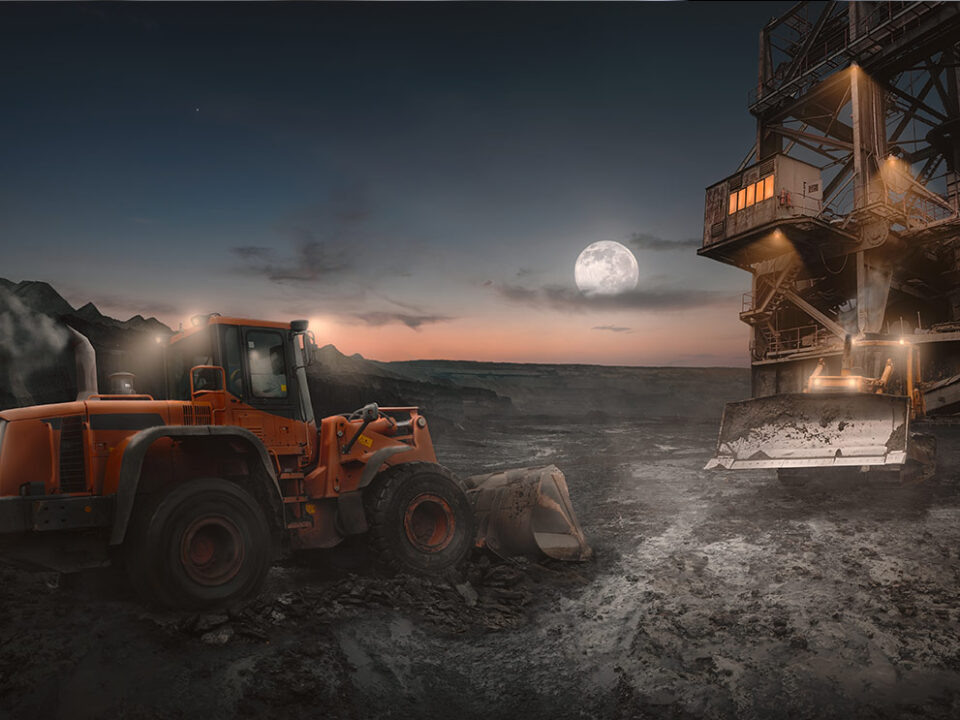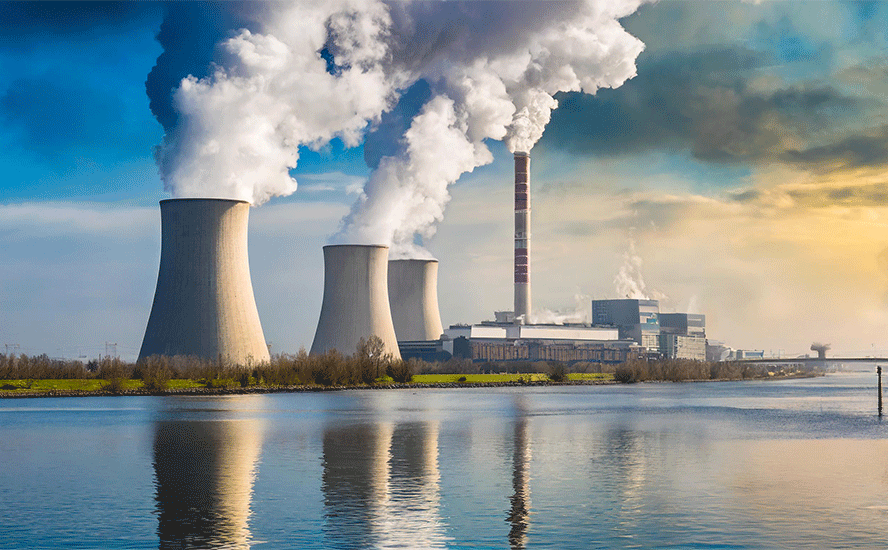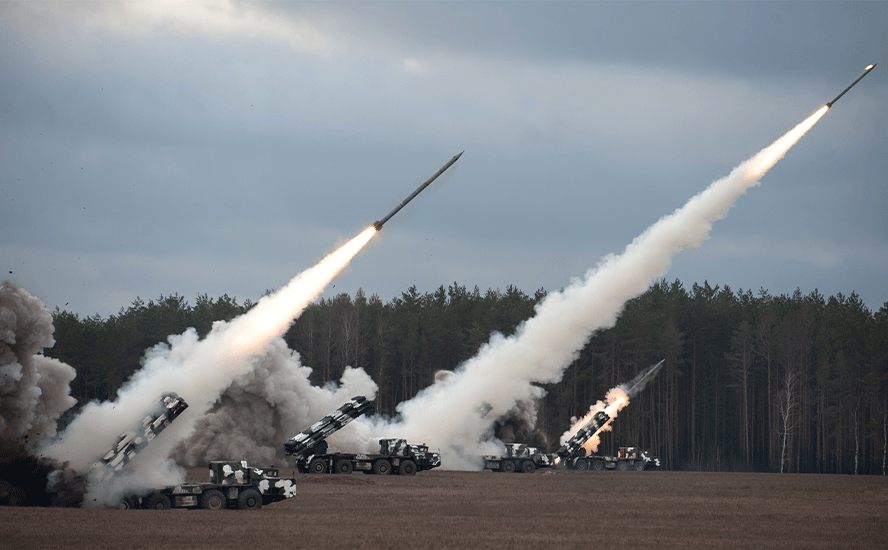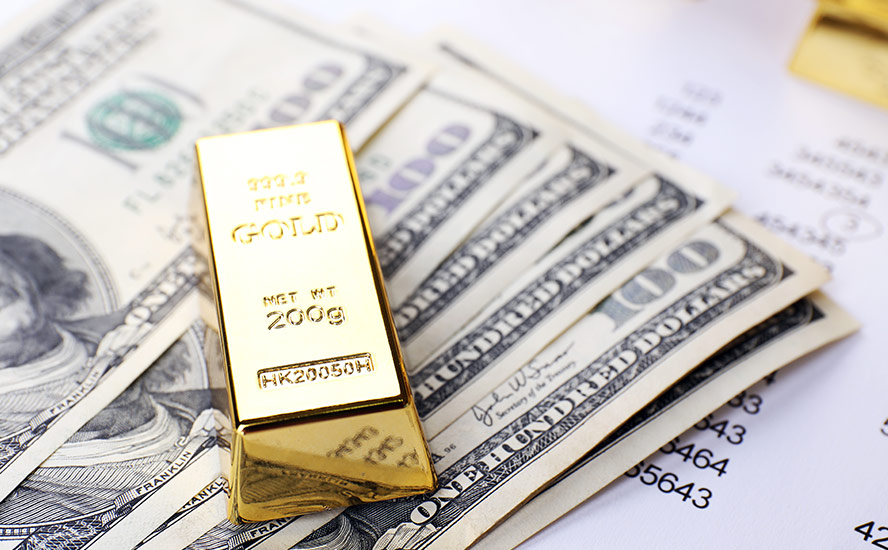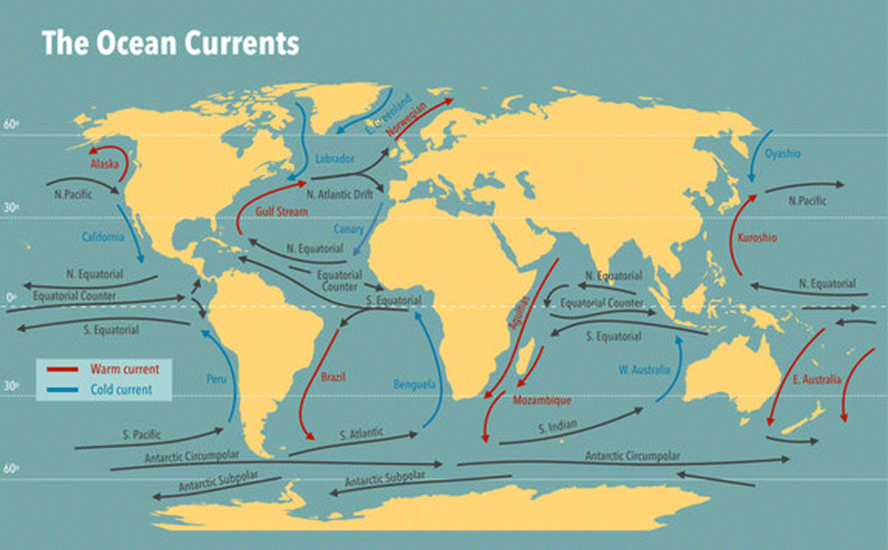Uranium’s ugly stepsister

2018.10.06
Most junior resource investors know uranium, and many got in on the action when NexGen Energy and Fission Uranium made their discoveries in the Athabasca Basin of Saskatchewan, the region with the highest grades of uranium in the world. Smart, or lucky, shareholders of NXE enjoyed a cumulative share price rise of around 430% between 2014 and 2016, while Fission Energy – famous for its Patterson Lake South property that yielded the open-pittable Triple R deposit – jumped from 91 cents in November 2013 to $1.62 a share in April 2014, for a gain of 78%.
Uranium is the fuel needed to create the nuclear reaction that can either create nuclear power or nuclear weapons. To make nuclear fuel from uranium ore, the uranium is first extracted from the rock, then enriched with the uranium-235 isotope, before being made into pellets that are loaded into assemblies of nuclear fuel rods. In a nuclear reactor, several hundred fuel assemblies containing thousands of small pellets of uranium oxide are in the reactor core. The nuclear chain reaction that creates energy starts when U-235 splits or “fissions”, which produces a lot of heat in a controlled environment.
In a conventional nuclear reactor, the pressurized water reactor, fuel rods containing uranium pellets are placed in water. Visualized as a giant kettle, the heat generated from the pellets boils water to create steam, which turns turbines to generate electricity. But the downside of conventional nuclear power stations is the nuclear reaction also produces plutonium, which is highly radioactive, and other wastes, causing a problem for disposal. Stronium-90 and cesium-137, contained in nuclear waste, have half-lives of about 30 years, but plutonium-239 takes 24,000 years to fully decay.
When it works well, the nuclear reaction is an efficient form of energy creation. One uranium pellet weighing just 6 grams is said to produce the same amount of energy as a tonne of coal. But it also leaves a lot of radioactive waste that needs to be incinerated, encased in concrete, or buried deep underground for centuries.
When nuclear power goes wrong, the fallout is catastrophic. Nuclear meltdowns like Chernobyl in Russia, Three Mile Island in the US, and Fukushima in Japan are burned into the collective consciousness and serve as constant reminders of the dangers of nuclear power that drive the anti-nuke movement.
While nuclear energy generation will never be without risks, proponents argue these are manageable and small compared to the risk of increased greenhouse gas emissions caused by the continued burning of fossil fuels for power, that are warming the planet. For this reason, nuclear is always in the mix of energies required to make the transformation from an oil-based economy to one where renewable and nuclear energies make up a larger proportion of our global electricity. The question is, must we keep using uranium in our nuclear power plants, or is there another option? There is. It’s uranium’s ugly stepsister, a little-known element known as thorium.
Some scientists believe thorium is key to developing a new version of cleaner, safer nuclear power. So why hasn’t thorium entered the popular and investor lexicon like uranium has? The silvery-white metal has a fascinating history, and despite taking a backseat to uranium as the primary nuclear fuel, it is making a comeback. This is the story of thorium, the wünder-fuel that wasn’t, but could be.
History
Thorium is named after Thor, the Norse god of thunder. It was first discovered in 1815 by Jöns Jakob Berzelius, a Swedish chemist, but a few years later it was determined that the mineral was actually yttrium phosphate. In 1828 Berzelius was given a sample of a black mineral found on an island off the coast of Norway by Hans Esmark, a Norwegian mineralogist. The mineral contained several known elements including lead, tin, iron, manganese and uranium, but 60% was an unknown substance that was subsequently named thorite. Thorium was first isolated by mixing thorium oxide with carbon, creating thorium chloride. When reacted with potassium, the result was thorium and potassium chloride, according to Chemicool. It took another 70 years for scientists to realize that thorium was radioactive. The discovery was made by Gerhard Schmidt, a German chemist, and Marie Cure, a Polish physicist, who are often credited with its discovery.
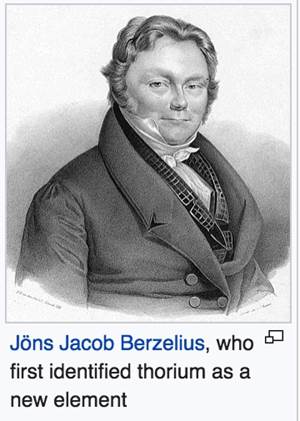
Thorium oxide (ThO2) has the highest melting point of all oxides (3300°C) so it’s not surprising that its early applications were in lantern mantles, arc-light lamps, welding electrodes and heat-resistant ceramics. Thorium oxide is also used in camera lenses and scientific instruments.
Abundance
Thorium is actually fairly common on Earth. According to Livescience it occurs in the Earth’s crust at 6 parts per million – about as much as lead and three times more abundant than uranium; it is the 41st most abundant element on Earth.
However it is thought to be rare because thorium is normally found as minor constituents of metals. Interestingly though, natural thorium occurs as almost pure 232Th, the most stable thorium isotope, which has a half-life comparable to the age of the universe (14 billion years), and whose radioactive decay is the largest contributor to the Earth’s internal heat. Right now it’s estimated the planet still has about 85% of the thorium present when the Earth was formed. Scientists at Los Alamos National Laboratory – where the first nuclear weapons were designed as part of the Manhattan Project – think that thorium was created in the cores of supernovae (the last stages of a star’s life), then scattered across the universe when the stars exploded.
Trace elements are found in rocks, soil, water, plants and animals, with higher concentrations contained within thorite, thorianite, monazite, allanite, and zircon. The element is mined mostly in Australia, Brazil and India. The rare earth mineral monazite contains between 6 and 12% thorium phosphate.
According to the World Nuclear Association (WNO) world monazite resources are estimated at around 16 million tonnes, 12MT of which are found in mineral sands deposits in India. A large vein deposit of thorium and rare earth elements is in Idaho. Recovering thorium from monazite involves leaching it with sodium hydroxide at 140°C followed by a process to precipitate pure ThO2. The WNO states that under 10,000 tonnes a year of monazite are extracted per year from India, Brazil, Vietnam and Malaysia, and “without commercial rare earth recovery, thorium production is not economic at present.”
Use in nuclear energy
The story gets really interesting when thorium was found to be radioactive – just two years after the discovery of uranium radioactivity by French physicist Henry Bequerel. Initially thorium’s radioactivity was thought to have health benefits, and was promoted as a cure for rheumatism, diabetes and even impotence. However in 1932 these uses were banned due to a federal investigation that found that people injected with thorium suffered from leukemia and abnormal chromosomes.
Attention then turned to the use of thorium in nuclear energy. During the Cold War the US looked at using 232Th to create 233U – which was being investigated as both a reactor fuel and to build nuclear bombs. But the US Military rejected a bomb built with 233U because it did not have “technical advantages” over uranium-plutonium bombs and especially since it it is difficult to produce pure 233U states a 1966 technical report.
Uranium’s chief advantage over thorium, as a nuclear fuel, was that it could be used to produce both atomic weapons and nuclear power, while thorium, unlike uranium, is not “fissile” – meaning it cannot be split to make a nuclear chain reaction – and could only be applied to nuclear power.
With the United States in the early stages of an arms race against the former Soviet Union to develop a nuclear arsenal, it was easy to see which element would win out. While thorium was used in a later version of America’s first civilian nuclear power plant – headed up by Hyman Rickover, the US admiral responsible for creating the world’s first nuclear-powered submarine – it would take a back seat to uranium as the primary fuel for nuclear reactors.
Thorium nuclear reactors were developed at the Oak Ridge National Laboratory to support nuclear-powered long-range bombers, but the program was scrapped in 1961 in favor of other technologies according to a 2009 NASA paper. This is because the liquid fluoride thorium reactors did not produce as much plutonium, needed for developing nuclear weapons, as uranium-powered reactors.
Nonetheless, the first thorium-based nuclear reactor was built at the Indian Point Energy Center, New York, in 1962.
As mentioned thorium is not able to split an atom to produce the nuclear reaction; instead, when thorium is exposed to neutrons, it eventually emerges into the isotope U-233, which splits and releases energy. In this way thorium is said to be “fertile” rather than fissile. Recycled plutonium can also be used with thorium.
Uranium vs thorium
Other than the fact that uranium is better than thorium in building nuclear weapons, how do the two nuclear fuels stack up against one another? According to the Royal Society of Chemistry, thorium’s benefits include:
- Thorium is three to four times more abundant than uranium. There is estimated to be enough thorium on the planet to last 10,000 years.
- Thorium is more easily extracted than uranium.
- Liquid fluoride thorium reactors (LFTR) – a type of molten salt reactor – have very little waste compared with reactors powered by uranium.
- It is more efficient. One tonne of thorium delivers the same amount of energy as 250 tonnes of uranium.
- LFTRs run at atmospheric pressure instead of 150 to 160 times atmospheric pressure currently needed for water cooled reactors.
- Thorium is less radioactive than uranium.
The 2011 Fukushima disaster in Japan soured the world on nuclear, and started scientists looking more closely at thorium as a “greener” alternative. While conventional nuclear plants are only able to extract 3-5% of the energy in uranium fuel rods, in molten salt reactors favored by thorium proponents, nearly all the fuel is consumed. Where radioactive waste from uranium-based reactors lasts up to 10,000 years, residues from the thorium reaction will become inert within 500. Lastly, because plutonium is not created as a waste product in a thorium reactor, it cannot be separated from the waste and used to make nuclear weapons. Although, the World Nuclear Association points out that the United States made about two tonnes of U-233 during the Cold War and detonated a nuclear weapon containing U-233. The explosive yield though was less than expected, just 22 kilotons. In 1998 India detonated a small nuclear device from U-233.
As far as disadvantages, thorium takes extremely high temperatures to produce nuclear fuel (550 degrees higher than uranium dioxide), meaning thorium dioxide is expensive to make. Second, irradiated thorium is dangerously radioactive in the short-term. Detractors also say the thorium fuel cycle is less advanced than uranium-plutonium and could take decades to perfect; by that time, renewable energies could make the cost of thorium reactors cost-prohibitive. The International Nuclear Agency predicts that the thorium cycle won’t be commercially viable while uranium is still readily available.
Molten salt nuclear reactors
Molten salt reactors (MSRs) are well suited to thorium fuel, and while they were first conceived of in the 1940s, as noted above, to fuel aircraft, there has been a renewed interest in them. In the Liquid Fluoride Thorium Reactor (LFTR), the fuel is not cast into pellets like uranium, but is rather dissolved in a vat of liquid salt.
According to ZME Science, since molten salt reactor technology was revived in the 2000s, interest has grown quickly, with four companies in the US announcing plans for MSRs, as well as in Japan, Russia, France and China. In Norway, Thor Energy started producing power from thorium at its Halden test reactor in 2013, with help from Westinghouse. The third phase of a five-year thorium trial operation got underway in January.
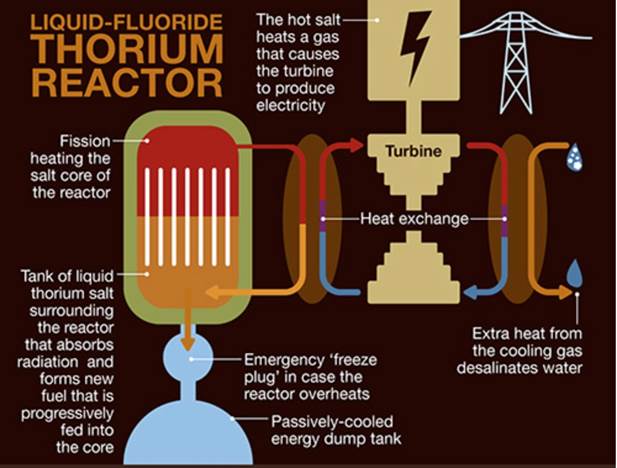
India’s thorium program is well advanced. The country envisions meeting 30% of its electricity demands through thorium-based reactors by 2050. With large quantities of thorium and little uranium, India wants to use thorium for large-scale energy production. It plans to construct and commission a fleet of 500 sodium-cooled fast reactors – which burn spent uranium and plutonium – in order to breed plutonium to be used in its advanced heavy water reactors that employ thorium as the nuclear fuel. A prototype of the 500-megawatt fast breeder reactor (FBR) in Kalpakkam, India was supposed to be finished in late 2017 but has been put off to later this year.
One of the main advantages of MSRs is the reactor cannot melt down, as we saw in Fukushima when electric pumps were inundated by the tsunami, failing to cool the fuel rods, which overheated and caused radiation emissions. MSRs can also be made cheaper and smaller than conventional reactors, since they do not have large pressurized containment tanks, meaning they could be used in factory settings. MSRs use molten salt instead of water as a coolant, allowing them to reach temperatures over 80°C, three times hotter than a conventional nuclear plant cooled with water.
Another advantage is that nuclear waste (ie. plutonium) can be recycled to recover the fissile materials needed to create the nuclear reaction. In this way, thorium reactors not only generate less waste than conventional reactors, but also help to rectify the nuclear waste disposal problem.
Work continues
Examples of companies and countries that are testing thorium’s viability as a nuclear fuel keep growing. Last summer a Dutch nuclear institute started experimenting with MSRs. NRG, the name of the facility, on the North Sea coast of the Netherlands, launched the Salt Irradiation Experiment in collaboration with the EU. New Scientist reports the researchers will use thorium as the nuclear fuel for the reactor where both the reactor fuel and the coolant are a mixture of molten salt. The experiment will also examine how to deal with the nuclear waste.
Indonesia, which has a large amount of thorium contained within monazite, signed an agreement three years ago with US company ThorCon Power, to develop molten salt reactors. A 1,000-megawatt thorium-based reactor would be used for base-load power and produce 5 gigawatts a year. The country wants around 20% of its energy mix to come from thorium molten salt reactors by 2050.
In the United States, the Department of Energy is partnering with TerraPower, Vanderbilt and the Oak Ridge National Lab, among others, to build a molten chloride fast reactor – a type of MSR – Oilprice.com reported. Southern Company in 2016 was the second firm to receive a grant from the DOE.
China, seemingly always on the leading edge of new energy, has put aside US$3.3 billion to build two molten salt reactors in the Gobi Desert, to be up and running by 2020, the South China Morning Post said in December. The reactors could spawn new uses for the radioactive element, including applications in warships and drones.
Conclusion
If there hadn’t been an urgent need to develop nuclear weapons for the Cold War, there’s a reasonably good chance that thorium rather than uranium would have become the nuclear fuel of choice. The ability of uranium to kickstart the nuclear reaction makes it one of the most strategically important minerals on Earth. If the world was running out of uranium, thorium demand, and the technology to make molten salt reactors, would probably be much farther advanced than it currently is. But we are not running out of uranium. According to the World Nuclear Association (WNA), in 2017, world uranium production totalled 59,531 tonnes, which satisfied 92% of world demand. The top producers are Kazakhstan, Canada and Australia. Total known, recoverable uranium resources as of 2015 were 5.718 million tonnes.
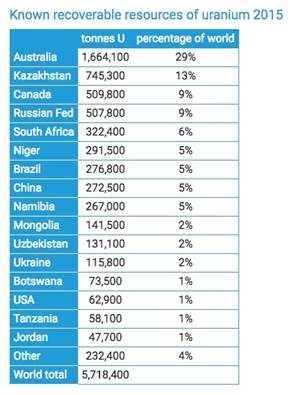
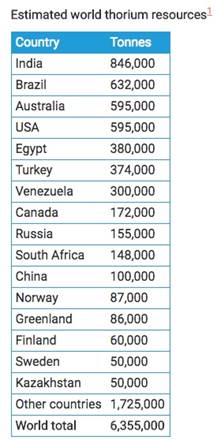
Contrast this with thorium. The WNA states there are 6.555 million tonnes of thorium resources in the world – with most thorium held in India, Brazil and Australia/ the US (tied for third). That’s a bit more than total uranium resources. But how much thorium is mined? According to the USGS, in 2017, only 2.2 tons of thorium (mostly monazite) were imported into the United States; thorium compound exports were 83 tons. Obviously the tiny numbers are because there is currently no market for thorium. But if there was, there are around 6 million tonnes of resources waiting to be converted into reserves. Quite an opportunity for thorium explorers should molten salt reactors ever catch on enough to augment, let alone replace, conventional uranium-based reactors. The demand for thorium fuel, and its price, would skyrocket.
For now, thorium is a theoretical solution to our energy dilemma, but it could be much more than that. A concerted effort to develop thorium reactor technology could provide stable, clean, base-load power for millions, something that is not possible with renewables due to the intermittency factor (ie. power can only be generated when the sun shines and the wind blows) and the current early stages of renewable battery storage technology. It is safer and better for the environment than uranium, and can even use radioactive waste as feedstock for the nuclear reaction, thus killing two birds with one stone. The market isn’t yet ready for thorium, but when it is, a whole new mining sector and supply chain will be born.
Thorium and its potential for resource exploration is on my radar screen.
Richard (Rick) Mills
Just read, or participate in if you wish, our free Investors forums.
Ahead of the Herd is now on Twitter.
Legal Notice / Disclaimer
This document is not and should not be construed as an offer to sell or the solicitation of an offer to purchase or subscribe for any investment.
Legal Notice / Disclaimer
Ahead of the Herd newsletter, aheadoftheherd.com, hereafter known as AOTH.Please read the entire Disclaimer carefully before you use this website or read the newsletter. If you do not agree to all the AOTH/Richard Mills Disclaimer, do not access/read this website/newsletter/article, or any of its pages. By reading/using this AOTH/Richard Mills website/newsletter/article, and whether you actually read this Disclaimer, you are deemed to have accepted it.


